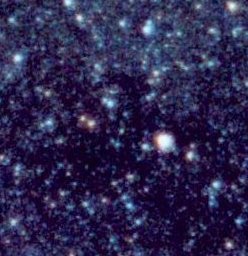
 |
Cygnus X-1 is the classic black hole binary. The visually bright component, a highly luminious class O supergiant called HDE 226868, is centered in the picture up and to the left of the picture's brightest star, Eta Cygni. The black hole, in tight orbit about the supergiant, is made eveident through X-rays radiated by hot gas flowing to it from the tidally distorted much larger star. The gap in the middle of the image is the result of the absorption of distant starlight by thick clouds of interstellar dust. Were they not there, Cyg X-1 (rather HDE 226868) would be visible to the naked eye. See a full labelled image and then a broader labelled view. |